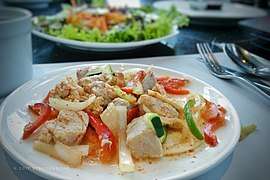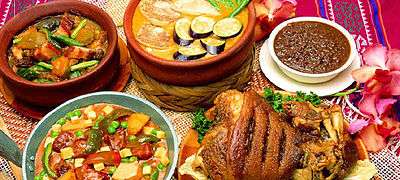Kinilaw
Kinilaw (literally "eaten raw") is a raw seafood dish and preparation method native to the Philippines. It is also referred to as Philippine ceviche due to its similarity to the Latin American dish Ceviche.[1][2] It is more accurately a cooking process that relies on vinegar and/or acidic fruit juices (usually citrus) to denature the ingredients, rather than a dish, as it can also be used to prepare meat and vegetables.[3]
  Top: traditional fish kinilaw from Cagayan de Oro; Bottom: kilawen kambing (goat meat kilawin) | |
| Alternative names | Philippine ceviche, kilawin, lataven |
|---|---|
| Course | Appetizer |
| Place of origin | Philippines |
| Serving temperature | Room temperature, cold |
| Main ingredients | Seafood/meat/vegetables, vinegar, calamansi, onion, ginger, salt, siling labuyo, black pepper |
| Variations | Kilawen, kilayen, lawal, biyaring, kulao |
| Similar dishes | Paksiw, Philippine adobo, sisig |
kilawin is a meat-based preparation method quite similar but not the same as kinilaw. It is more common in the northern Philippines and use blanched and lightly grilled meat (not raw).[4] Kinilaw dishes are usually eaten as appetizers before a meal, or as finger food (Tagalog: pulutan) with alcoholic drinks.[5]
Description
The most common kinilaw dish is kinilaw na isda ("fish kinilaw") prepared using raw cubed fish mixed with vinegar (usually coconut vinegar or cane vinegar) as the primary denaturing agent; along with a souring agent to enhance the tartness like calamansi, dayap, biasong, kamias, tamarind, green mangoes, balimbing, and green sineguelas. It is flavored with salt and spices like black pepper, ginger, onions, and chili peppers (commonly siling labuyo or bird's eye chili).[1][3] An average serving of fish kinilaw contains just 147 calories.[6]
To neutralize the fishy taste and the acidity before serving, juice extracts from the grated flesh of tabon-tabon fruits (Atuna racemosa), dungon fruits (Heritiera sylvatica and Heritiera littoralis), or immature small young coconuts are also commonly added. Extracts from the bark scrapings of sineguelas or bakawan trees (Rhizophora mangroves) are also used similarly.[7][1] Some regional variants also add gatâ (coconut milk), sugar, or even soft drinks to reduce the sourness.[4][3]
Popular kinds of fish used in kinilaw include tanigue or tangigue (Spanish mackerels, king mackerel, or wahoo), malasugi (marlins or swordfish), tambakol (yellowfin tuna), bangus (milkfish), and anchovies.[5][8][9]
Kilawin
Variants predominantly from the northern Philippines use meat (usually called kilawin to distinguish them from other kinilaw), including goat meat, beef, carabao, pork, and chicken. Unlike fish kinilaw, meat kilawin are not eaten raw but are cooked by boiling or grilling or both. They are usually done rare to medium rare, though in some cases the meat are fully cooked. Meat-based kilawin are also traditionally eaten with papaít (literally "bittering agent"), usually the bile extracted from the gall bladder or by squishing the chewed grass in an animal's stomach.[4][10][11]
Seafood used in kinilaw must be fresh and properly cleaned, as there are health hazards involved with consuming raw seafood; in kilawin the partly cooked meat has to be fresh and properly cleaned as well.[5][3]
Other seafood
Other ingredients that can be used to make kinilaw include shrimp, squid, clams, oysters, crabs, sea urchin roe, seaweed, jellyfish, shipworms (tamilok) or even beetle larvae (grubs), among others. They vary in terms of preparation, depending on the ingredients, from raw to fully cooked.[1] For example, shrimp are prepared raw,[12] while squid needs to be blanched first to tenderize the flesh.[13]
Salads
Kinilaw also refers to dishes using raw fruits and vegetables marinated in vinegar and spices, in which case the dishes are sometimes referred to by the Spanish term ensalada ("salad"). Examples include cucumbers (pipino), bitter melons (ampalaya), young sweet potato (camote) leaves, young papaya, vegetable ferns (pako), and banana flowers.[4][1]
History
Kinilaw is native to the Philippines. The Balangay archaeological excavation site in Butuan (dated c. 10th to 13th century AD) has uncovered remains of halved tabon-tabon fruits and fish bones cut in a manner suggesting that they were cubed, thus indicating that the cooking process is at least a thousand years old.[1][3] It was also described by Spanish colonists and explorers to the Philippines, with the earliest mention being in the Vocabulario de la lengua tagala (1613) as cqinicqilao and cquilao,[8] a Hispanicized spelling of the Visayan verb kilaw ("to eat raw"), and a cognate of the adjective hilaw ("raw", "uncooked", or "unripe").[14][15][16] Other sources that mention it include the Vocabulario de la lengua Pampanga en romance (1732) as quilao; and in the 1754 edition of Vocabulario de la lengua tagala as quilauin.[3]
Unlike Latin American ceviches, which exclusively use citrus juices (which are not native to the Americas), kinilaw instead primarily uses vinegar in addition to citrus (native to tropical Asia), and other acidic fruit juices.[3][8]
Regional names and variants
Some of the oldest surviving kinilaw variants are from the southern Visayas and Northern Mindanao, like Cagayan de Oro's kinilaw (sometimes stylized as kinilaw de Oro) and Dumaguete's binakhaw. Both are direct descendants of ancient Visayan preparation methods as displayed in the Butuan archeological finds. These are the original versions that use tabon-tabon and dungon fruits respectively.[17][18]
Several regions of the Philippines have local specialties or names of kinilaw dishes. In the northern Philippines, the Ivatan people of the Batanes islands refer to kinilaw as lataven. Ivatan fish kinilaw is known as lataven a among (also spelled lataven a amung).[19][3] In Ilocos, the Ilocano kilawin kalding or kilawen specifically refers to lightly grilled goat meat kinilaw. Among the Kapampangan people of Pampanga, quilain (also spelled kilayen or kilayin) or quilain babi refers to kinilaw that use fully cooked pork, heart, liver, and tripe. A similar dish among the Caviteño Tagalogs uses fully boiled pork ears, and is known as kulao or kilawin na tainga ng baboy. When mixed with fried tokwa (tofu) cubes, kulao becomes the more familiar dish tokwa't baboy.[20][21][22] Modern variants of this dish use soy sauce in addition to the other ingredients.[23]
In the southern Philippines, the Tausug people of the Sulu islands refer to fish kinilaw as lawal. Unlike other kinilaw dishes, lawal only uses vinegar to wash the fish, and primarily relies on citrus fruits and other souring agents to denature the fish meat.[19][24] Among the Maranao people of southwestern Mindanao, biyaring is a type of kinilaw made with tiny shrimp. It is a regional favorite and is notable because it is ideally prepared while the shrimp are still alive.[25][26] Among the Sama-Bajau people, it is known as kilau or kinilau and sometimes includes unripe mangoes as a souring agent.
A common way of serving kinilaw in the islands of Visayas and Mindanao is sinuglaw, which combines fish kinilaw (usually tuna) and charcoal-grilled pork belly (sinugba).[27]
_-_Philippines_2.jpg) Kinilaw na gusô
Kinilaw na gusô
(sea grapes).jpg) Kinilaw na malasugi
Kinilaw na malasugi
(marlin)- Kinilaw na malasugi
(marlin) - Kilawin na pusô ng saging
(banana flowers) .jpg) Kinilaw nga galay sa camote
Kinilaw nga galay sa camote
(camote leaves)
 Fish kinilaw with chili flakes
Fish kinilaw with chili flakes.jpg) Ensaladang kangkong
Ensaladang kangkong
(water spinach)
See also
- Kelaguen, a Chamorro dish derived from kilawin
- 'Ota 'ika, a similar Polynesian dish
- Poke (Hawaiian dish), a similar Hawaiian dish
- Paksiw
- Philippine adobo
- List of raw fish dishes
- Filipino Cuisine
- List of Philippine dishes
References
- Alan Davidson (2014). The Oxford Companion to Food. OUP Oxford. pp. 445–446. ISBN 9780191040726.
- The Appetizer Atlas: A World of Small Bites, p. 189
- Ninah Villa (27 June 2015). "Kinilaw History, Origin and Evolution – Into the Heart of Freshness". Pinoy Wit. Retrieved 16 January 2017.
- Elena Peña (24 June 2016). "Wow! Kinilaw". The Philippine Star. Retrieved 16 January 2017.
- "Kinilaw na Malasugi / Swordfish Seviche". Market Manila. 23 April 2006. Retrieved 16 January 2017.
- "Calories in Fish Kinilaw and Nutrition Facts". www.fatsecret.com. Retrieved 2019-04-15.
- "Tabon Tabon Fruit". Market Manila. 8 January 2008. Retrieved 16 January 2017.
- "Kinilaw". Eat Your World. Retrieved 16 January 2017.
- "Kinilaw na Tanigue".
- "Kilawing Kambing Recipe". My Filipino Recipes. Archived from the original on 2011.
- "Kilawing Kambing Recipe". MyFilipinoRecipes.com. Retrieved 16 January 2017.
- Clinton Palanca (12 March 2015). "How to make 'kinilaw'–from the 'kinilaw mast". Inquirer. Retrieved 16 January 2017.
- "Kinilaw na Pusit (Marinated Squid)". Jinkzz's Kitchen. 10 September 2011. Retrieved 16 January 2017.
- "Kinilaw". Binisaya.com. Retrieved 16 January 2017.
- "Kelaguen/Kilawin". Saint Fidelis Friary. 9 March 2015. Retrieved 16 January 2017.
- "History of Kinilaw". KinilawMix.com. Retrieved 16 January 2017.
- Taguchi, Yasunari Ramon Suarez (18 May 2018). "Versions of the "Kinilaw"". The Freeman. Retrieved 30 December 2018.
- Mapa, Tata (5 July 2016). "Everything you need to know about kinilaw". waytogo. Retrieved 30 December 2018.
- "Filipino fish and seafood dishes - L". Glossary of Filipino Food. Retrieved 16 January 2017.
- "Kulao". The Kitchen Invader. 4 September 2015. Retrieved 17 January 2017.
- "Kilawin na Tainga ng Baboy". Mely's Kitchen. Retrieved 17 January 2017.
- "Kilawing Tokawa't Baboy". FoodRecap. 24 September 2001. Archived from the original on 18 January 2017. Retrieved 17 January 2017.
- "Kulao". Lutong Cavite. 28 January 2013. Retrieved 17 January 2017.
- Edgie B. Polistico (18 December 2010). "Pinoy Food and Cooking Dictionary - K". Edgie Polistico's Encyclopedic Philippine Food, Cooking, and Dining Dictionary. Retrieved 16 January 2017.
- Michael Jansen (14 January 2013). "Great Muslim Dishes in Small Towns". Muslim Academy. Retrieved 16 January 2017.
- "Biyaring or Kinilaw na Hipon". Maranao Recipe. 23 November 2012. Retrieved 16 January 2017.
- "Sinuglaw". Panlasang Pinoy. Retrieved 24 September 2019.
